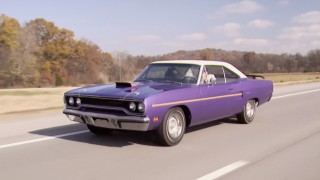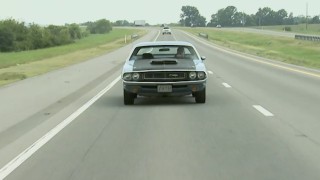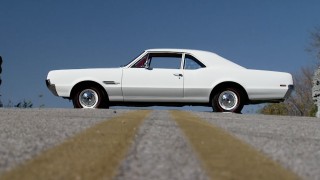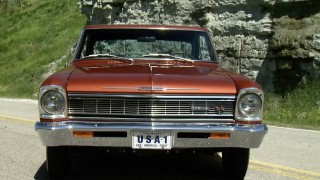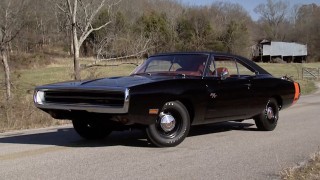Want more content like this?
Join the PowerNation Email NewsletterVideo Transcript
(Music)
The Chevrolet Corvette was named after a smaller class of warship originally designed for speed and maneuverability, which is an accurate description of a '67 Sting Ray with the original 427 big block under the hood. This Vette has been fully restored with all n-o-s parts and can fly like a stinger missile.
(Tommy)>> The 427 boasts 435 horses and 460-foot pounds of torque. Plus can go from zero to 60 in 5.6 seconds. In '67 it cost a little over $5,000, but now it's worth more than a small house.
(Joel)>> The '67 Sting Ray was a big hit with its inclusion of bolt on wheels, side pipes, and a sleek body design that made it look fast even when it was sitting still.
(Tommy)>> Now to many the '67 was the pinnacle achievement for the Corvette brand. GM chief designer Harley Earl debuted the original in 1953. It had an all fiberglass body, which was a first for an American made car, and every Corvette since then has followed that formula.
(Joel)>> People quickly fell in love with its distinct style, but they weren't crazy about only having a 150 horse six banger truck motor under the hood. Around 1954 the Corvette started losing ground to Ford's two seater TBird, and in 1955 only about 700 were sold. Swooping in to save the day was GM engineer Zora Arkus-Duntov, who dropped in a V-8 engine coupled with a three speed transmission, boosting the horsepower to 195.
(Tommy)>> In 1963 GM designer Bill Mitchell did a complete revamp of the Corvette and introduced the Sting Ray moniker. During that time many refinements were made including independent rear suspension, side exhaust pipes, four wheel disc brakes, and that killer 427 V-8 with a raised hood scoop. If you saw a stinger and that checkered flag coming at you in the rearview you better look out.
(Joel)>> Part of those 435 horses were derived from the triple Holley two barrel carburetors known as the Tri-Power. They were first introduced in '67 and were capable of sucking in 1,000 cubic feet of air per minute. This option was a little over $400 bucks, which meant it costs about a dollar per horsepower.
(Tommy)>> Some other changes in '67 were the optional bolt-on alloy wheels, functional five slotted fender vents, and a parking brake relocated between the seats. The '67 Corvette still had plenty of chrome to go around, and of course those aerodynamic retractable headlights.
(Joel)>> The rally red exterior with matching interior is unique. Sitting in that driver's seat is designed to make you feel like you're flying a fighter jet, which is why they chose the name Corvette, and the Sting Ray performs extremely well thanks to its four wheel independent suspension.
(Tommy)>> '67 was the end of an era for the Corvette. It was the last of the C-2s, and some enthusiasts even feel it was the last of the true Corvettes. Corvettes have gone through many transitions but one thing still remains the same. People love them everywhere you go.
Show Full Transcript
The Chevrolet Corvette was named after a smaller class of warship originally designed for speed and maneuverability, which is an accurate description of a '67 Sting Ray with the original 427 big block under the hood. This Vette has been fully restored with all n-o-s parts and can fly like a stinger missile.
(Tommy)>> The 427 boasts 435 horses and 460-foot pounds of torque. Plus can go from zero to 60 in 5.6 seconds. In '67 it cost a little over $5,000, but now it's worth more than a small house.
(Joel)>> The '67 Sting Ray was a big hit with its inclusion of bolt on wheels, side pipes, and a sleek body design that made it look fast even when it was sitting still.
(Tommy)>> Now to many the '67 was the pinnacle achievement for the Corvette brand. GM chief designer Harley Earl debuted the original in 1953. It had an all fiberglass body, which was a first for an American made car, and every Corvette since then has followed that formula.
(Joel)>> People quickly fell in love with its distinct style, but they weren't crazy about only having a 150 horse six banger truck motor under the hood. Around 1954 the Corvette started losing ground to Ford's two seater TBird, and in 1955 only about 700 were sold. Swooping in to save the day was GM engineer Zora Arkus-Duntov, who dropped in a V-8 engine coupled with a three speed transmission, boosting the horsepower to 195.
(Tommy)>> In 1963 GM designer Bill Mitchell did a complete revamp of the Corvette and introduced the Sting Ray moniker. During that time many refinements were made including independent rear suspension, side exhaust pipes, four wheel disc brakes, and that killer 427 V-8 with a raised hood scoop. If you saw a stinger and that checkered flag coming at you in the rearview you better look out.
(Joel)>> Part of those 435 horses were derived from the triple Holley two barrel carburetors known as the Tri-Power. They were first introduced in '67 and were capable of sucking in 1,000 cubic feet of air per minute. This option was a little over $400 bucks, which meant it costs about a dollar per horsepower.
(Tommy)>> Some other changes in '67 were the optional bolt-on alloy wheels, functional five slotted fender vents, and a parking brake relocated between the seats. The '67 Corvette still had plenty of chrome to go around, and of course those aerodynamic retractable headlights.
(Joel)>> The rally red exterior with matching interior is unique. Sitting in that driver's seat is designed to make you feel like you're flying a fighter jet, which is why they chose the name Corvette, and the Sting Ray performs extremely well thanks to its four wheel independent suspension.
(Tommy)>> '67 was the end of an era for the Corvette. It was the last of the C-2s, and some enthusiasts even feel it was the last of the true Corvettes. Corvettes have gone through many transitions but one thing still remains the same. People love them everywhere you go.

